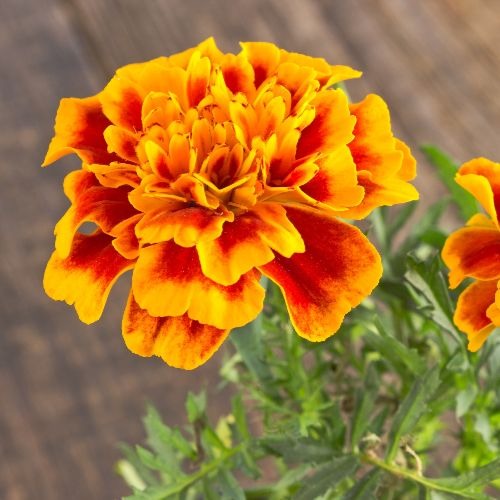How to Grow French Marigolds
French marigolds are a beautiful addition to any garden or landscape, with their vibrant and colorful blooms that add a burst of warmth and cheerfulness to any space. Growing these lovely flowers from seed is a fun and rewarding experience that can be enjoyed by gardeners of all levels. In this article, we will cover everything you need to know about how to grow French marigolds from seed.
Getting started Before you begin, you will need to gather your supplies. You will need high-quality French marigold seeds, seed starting mix, plant labels, a seed tray or pots, and a watering can or spray bottle. You will also need access to a sunny location or a grow light for optimal growth.
How to Sow French Marigold Seeds
Sowing the seeds Start by filling your seed tray or pots with seed starting mix. Moisten the mix by misting it with water until it is evenly damp, but not soaking wet. Next, sprinkle the French marigold seeds over the surface of the mix, spacing them about an inch apart. Cover the seeds with a thin layer of seed starting mix, about 1/8 inch thick, and gently press down on the surface to ensure good seed-to-soil contact.
Label your tray or pots with the name and date of planting, and place them in a warm, bright location. If you are using a grow light, position it about 6 inches above the seedlings. Keep the soil evenly moist, but be careful not to overwater, as this can cause the seeds to rot.
Soil and Light Requirements
French marigolds prefer well-drained soil that is rich in organic matter. They also need plenty of bright sunlight to grow and bloom properly. If you are planting them outdoors, choose a location that receives at least six hours of direct sunlight per day. If you are growing them indoors or in a greenhouse, use a grow light to supplement natural light.
Temperature Requirements
French marigolds prefer warm temperatures, and they will not tolerate frost or cold temperatures. To ensure optimal growth and blooming, keep the temperature between 65-75°F during the day and no lower than 55°F at night.
Watering Techniques
When watering your French marigold seedlings, use a watering can or spray bottle to gently moisten the soil surface. Avoid pouring water directly onto the plants, as this can damage the delicate stems and leaves. Water early in the day to allow the soil to dry out slightly before nightfall.
Germination
Seed Starting Mix
When selecting a seed starting mix, choose one that is specifically formulated for starting seeds. These mixes are typically sterile, lightweight, and provide good drainage. Avoid using garden soil or potting soil, which can be too heavy and may contain weed seeds or disease organisms.
Germination Time
Germinating French marigold seeds typically germinate within 5-10 days, but it can take up to two weeks in cooler temperatures. Once the seedlings have emerged, remove any plastic covers or domes to prevent the build-up of excess moisture. Continue to keep the soil evenly moist and provide plenty of bright light.
Thinning and transplanting
Once your seedlings have grown their first set of true leaves, it is time to thin them out. This will help prevent overcrowding and ensure that each plant has enough space to grow strong and healthy. Using a pair of scissors or small snips, carefully remove the weakest seedlings, leaving the strongest and healthiest plants in place. Aim to space the remaining plants about 4-6 inches apart.
Growing French Marigolds in Containers
If you are growing your French marigolds in pots, you may need to transplant them into larger containers as they grow. Choose pots that are at least 6-8 inches deep and wide, and fill them with a high-quality potting mix. Carefully remove the seedlings from their original pots, taking care not to damage the roots, and plant them at the same depth they were growing before.
Caring for your French marigolds French marigolds are relatively easy to care for, and with the right conditions, they will bloom profusely throughout the growing season. Here are some tips for caring for your French marigolds:
Care, Pests & Maintenance
Watering: French marigolds prefer well-drained soil that is evenly moist but not waterlogged. Water your plants when the soil feels dry to the touch, being careful not to overwater.
Deadheading: To encourage continuous blooming, pinch off spent flowers regularly. This will also prevent the plants from going to seed too quickly.
Pest control: French marigolds are generally resistant to pests and diseases, but they can occasionally fall victim to aphids or spider mites. If you notice an infestation, treat the plants with an insecticidal soap or oil.
How to Fertilize French Marigolds
Fertilizing French Marigolds properly can help promote healthy growth and vibrant blooms. Here are some steps to fertilize French marigolds:
- Choose the right fertilizer: French marigolds prefer a balanced fertilizer with equal amounts of nitrogen, phosphorus, and potassium. Look for a fertilizer with an N-P-K ratio of 10-10-10 or 20-20-20.
- Apply the fertilizer: Spread the fertilizer evenly around the base of the plants, being careful not to get any on the leaves. You can either sprinkle the fertilizer granules directly on the soil or dissolve them in water and pour the mixture over the soil.
- Water the plants: After applying the fertilizer, water the plants deeply to help the nutrients reach the roots. Avoid getting water on the leaves, as this can promote fungal growth.
- Repeat as needed: Depending on the type of fertilizer you use, you may need to fertilize French marigolds every 4-6 weeks throughout the growing season. Always follow the instructions on the fertilizer package for best results.
In addition to fertilizing, be sure to provide French marigolds with plenty of sunlight, water, and well-draining soil to help them thrive.
Harvesting seeds
If you want to save seeds for future planting, wait until the flowers have fully bloomed and the petals have fallen off. The center of the flower will form a green, ball-shaped seed pod. Allow the pod to dry on the plant until it turns brown and starts to crack open. Once the pod has opened, carefully remove the seeds and store them in a cool, dry location until you are ready to plant them.
French Marigold Companion Planting
French marigolds are popular among gardeners for their bright, cheerful blooms and their ability to repel pests. They are also known for their ability to enhance the growth and health of certain plants when grown together in a practice known as companion planting.
Companion Plants
Companion planting involves growing certain plants in close proximity to one another in order to promote mutual benefits. Here are some plants that are commonly grown with French marigolds:
- Tomatoes: French marigolds are often planted alongside tomato plants to help repel nematodes, a type of worm that can damage tomato roots. Please note, there is some anecdotal evidence to suggest that planting French marigolds too close to these plants may actually have a negative effect on their growth and productivity. This is because French marigolds contain a chemical called alpha-terthienyl, which can be toxic to some plants in the nightshade family, including tomatoes, peppers, and eggplants. The exact mechanism by which this chemical affects these plants is not fully understood, and some gardeners have reported success with planting French marigolds alongside their nightshades.
- Peppers: Peppers can also benefit from being planted with French marigolds, as they are susceptible to the same nematodes as tomatoes.
- Cabbage: French marigolds can help protect cabbage from pests like cabbage moths and cabbage loopers.
- Broccoli: Similarly, French marigolds can help protect broccoli from pests like aphids, cabbage worms, and root maggots.
- Beans (Keep some distance): French marigolds can help repel Mexican bean beetles, a common pest of bean plants.
It’s worth noting that companion planting is not a foolproof method of pest control, and it may not work in all situations. However, it can be a helpful tool for gardeners looking to reduce their use of pesticides and promote healthy plant growth.
Plants to Avoid with French Marigold
Here are some plants that are best avoided when planting French marigolds:
- Brassicas: French marigolds are known to release a chemical that can inhibit the growth of brassicas, such as broccoli, cauliflower, and cabbage.
- Beans: French marigolds may also interfere with the growth of beans, so it’s best to keep them apart.
- Nightshades (Keep some distance): Plants in the nightshade family, such as tomatoes, peppers, and eggplants, may also not thrive when planted near French marigolds.
- Radishes: Some gardeners report that French marigolds can stunt the growth of radishes, so it may be best to plant them separately.
- Strawberries: French marigolds may attract spider mites, which can also harm strawberries.
It’s worth noting that there isn’t a lot of scientific research on which plants are negatively affected by French marigolds, so some trial and error may be required to determine which plants grow best with them. In general, however, French marigolds are considered to be a beneficial addition to most gardens.
Conclusion Growing French marigolds from seed is a fun and rewarding experience that can add a beautiful burst of color to any garden or landscape. By following the steps outlined in this article, you can successfully grow French marigolds from seed and enjoy their lovely blooms throughout the growing season. Remember to provide your seedlings with plenty of light, keep the soil moist but not waterlogged, and thin and transplant your plants as needed. With a little care and attention, your French marigolds will thrive and bring joy to your garden for years to come.





Hello.
Great guide on how to grow French marigolds from seed! The step-by-step instructions are easy to follow and the tips for caring for the plants are very helpful.
Thanks for sharing.